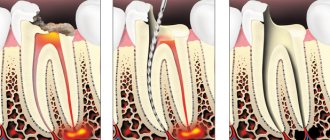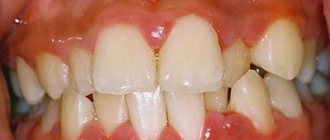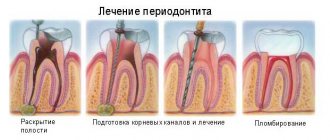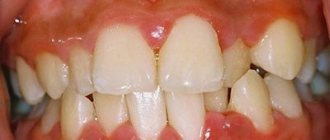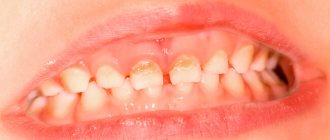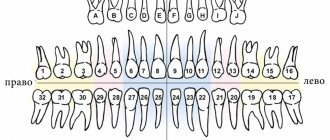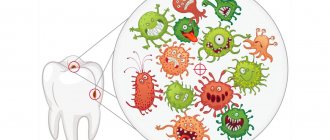Manifestation of periodontitis
Periodontitis is not difficult to recognize. It manifests itself in the form of periodontal inflammation. These are the tissues surrounding the root of the tooth. They are located next to the alveolar socket. The disease manifests itself in the form of unpleasant sensations when eating and chewing any food. Hot and cold foods sometimes cause acute, unbearable pain.
Outwardly, in the early stages, the disease may not manifest itself. But in a neglected state, blisters appear on the gums, and pus gradually leaks from the deep periodontal tissues and enters the oral cavity.
At the first symptoms, the main thing is to prevent inflammation from developing further. Exacerbation can lead to subsequent tooth extraction.
Subsequent development of the disease can contribute to the appearance of:
- dental granuloma;
- cysts;
- sepsis;
- osteomelitis.
The first signs of periodontitis:
- Swelling of the gums.
- An enlarged lymph node in the area where the source of the disease is located.
- Severe pain at the point of touching the affected area of the tooth (near the root tissue).
- Constant pain when eating food, especially hot food, including drinks.
- Feeling unwell in too hot weather.
- Weakening of gum tissue.
- Loose teeth.
The inflammatory process develops gradually. At first, the patient feels mild pain when chewing food. He then notices how his gums have become looser, especially in the affected areas. The appearance of granules on the surface of periodontal tissue can develop into the development of a fistula, pus from which will periodically leak into the oral cavity. After this, the patient will feel better, but then the disease will return again.
Teeth with periodontitis become darker. X-rays during a dental examination can reveal destroyed dentin and bone tissue.
DIAGNOSIS OF GRANULATING PERIODONTITIS
The main symptom of granulating periodontitis is subcutaneous granulomas or fistulas, but the disease can occur without visible changes. Instrumentally, pathology can be detected using a probe and assessing electrical sensitivity. There is a change in the threshold of excitability and slight painful sensations in the area of vertical percussion.
In response to pressure with the probe, the gum mucosa first turns pale, then turns intensely red. You can distinguish the disease from pulpitis by the shade of the crown - it becomes grayish, and with pulpitis it retains its normal color. To differentiate the disease from the granulomatous form of periodontitis, an x-ray examination is prescribed.
DIFFERENTIAL DIAGNOSTICS AND RADIOGRAMS
Radiography helps clarify the diagnosis, establish the causes of the pathology and develop treatment tactics. The image clearly visualizes the deformation of the gap between the root cement and the alveolus. In the area of the root apex, areas of destruction or rarefaction of bone tissue are visible, the edges of the plate lose clarity of contours, the affected area is characterized by an irregular “eaten away” shape without clear boundaries. In the granulomatous form of the disease, the image shows the regular round shape of the focus of bone destruction with clear boundary lines.
Types of periodontitis
p>Treatment of the disease depends on the degree of its development. To do this, you need to know about the different types of periodontitis. These include:
- Fibrous. Chronic stage. Diagnostics show that this disease often affects older people, whose periodontal tissues lose their strength over time.
- Granulating periodontitis. One of the most dangerous types of diseases. Usually the disease develops when there is no treatment for caries. Leads to the appearance of granular formations on the gums, which can subsequently grow.
- Granulomatous. Characterized by the appearance of formations in the area of the tooth root.
The disease can occur in three stages: acute, chronic or acute. In the latter case, periodontitis is chronic, but sometimes signs of exacerbation of the disease appear, followed by remission.
Diagnostics
The diagnosis is carried out by a doctor in a dental office. The process begins with listening to the patient's complaints and collecting an anamnesis, and this is followed by examination of the oral cavity, palpation of the site of inflammation and x-ray examination.
Granulating periodontitis has three stages of disease development:
- Swelling and bleeding of the gums, rapid formation of tartar.
- The necks of the teeth become exposed and become sensitive to external influences.
- An inflammatory process begins, causing destruction of bone and connective tissue.
Treatment methods for periodontitis
Chronic periodontitis, like the disease in its acute form, should be treated immediately after its detection. However, the ways to combat it differ depending on the type of disease. The standard algorithm for getting rid of the problem includes:
- Preparation. First, the doctor takes an x-ray to check the root canal.
- Nerve removal. Depulpation is required to further clean the canal.
- After drilling the tooth, the nerves are removed and the canals are cleaned. The old filling is also removed.
- Sometimes expansion of channels is required. Depends on the stage of the disease and the shape of the tooth.
- After treating the canal with an antiseptic, temporary filling is performed using special medications.
- Next is the reuse of antiseptics.
- If the inflammation has subsided, a permanent filling is applied.
- An x-ray is taken to monitor the outcome of the treatment.
Treating the disease is not as easy as it seems. Sometimes a temporary filling can be applied several times, and treatment can continue for several months. It depends on the severity of the disease and the experience of the doctor. Therefore, it is important to contact practicing specialists in licensed clinics.
Treatment
Standard surgery does not always give results, so dental surgeons often have to perform resection of the apical part of the root, hemisection and cystectomy. If this does not lead to a cure, then tooth extraction is performed.
Treatment of chronic granulating periodontitis is carried out comprehensively and is aimed at eliminating the source of infection and preventing its spread, eliminating pathogenic microorganisms in the root canal of the tooth, its high-quality, thorough filling and restoration of the functional and aesthetic characteristics of the crown of the tooth.
Treatment is carried out in several stages; His priority is methods that allow you to save the tooth. As a rule, several visits to the dentist are required, at the first of which he opens the tooth cavity and performs mechanical treatment of the root canals, disinfects and, after applying antiseptic agents, places a temporary filling. During the second visit, the canals are washed and filled with medicinal pastes. If the patient has no complaints and the treatment proceeds according to the planned plan, during the third visit, permanent root canal filling is performed.
Complications of periodontitis
Periodontitis itself is dangerous due to tooth loss and significant deterioration of periodontal tissue. The disease is characterized by a rapid transition to chronic stages, which lead to more severe oral problems.
Exacerbation of granulating periodontitis can lead to the formation of an odontogenic fistula. These are holes on the mucous surface through which pus comes out.
The danger is that the appearance of a fistula is not always limited to the oral cavity. In dentistry, there are cases where fistulas due to periodontitis appear on the cheeks and the outer surface of the face. This causes discomfort and worsens the appearance of patients.
The appearance of a fistula is characteristic of the chronic course of the disease with alternating stages of exacerbation. When the pus passes through the fistula canal, the patient feels lighter. A period of remission begins.
However, soon the pus appears again, the pain increases and becomes more frequent, and the tooth tissue continues to rapidly deteriorate. Therefore, you should not expect that after the first release of pus from the fistula canal, the disease will recede on its own.
Recommendations after treatment
After the operation, it is possible to save the affected tooth if it was performed in a timely manner. But you need to take into account that the disease may reappear if you do not follow the dentist’s recommendations and do not monitor the health of your teeth. To avoid relapse of granulating periodontitis after treatment, follow 4 rules:
- Never allow caries and pulpitis to progress. Severe stages of the disease can provoke the development of periodontitis.
- See your healthcare provider every 6 months for a diagnosis and professional cleaning. Professional oral hygiene eliminates soft and hard plaque, as well as all pathogenic bacteria.
- Use dental floss and a toothpick to remove food debris from hard-to-reach areas. Brush your teeth at least 2 times a day.
- Strengthen your immune system, take a vitamin-mineral complex and lead a healthy lifestyle.
Following these recommendations will help you maintain healthy teeth and gums for many years.
Have you encountered this unpleasant disease? Do not delay treatment - contact the dentistry of the CELT clinic!
Make an appointment through the application or by calling +7 +7 We work every day:
- Monday—Friday: 8.00—20.00
- Saturday: 8.00–18.00
- Sunday is a day off
The nearest metro and MCC stations to the clinic:
- Highway of Enthusiasts or Perovo
- Partisan
- Enthusiast Highway
Driving directions
Prevention of periodontitis
Periodontitis is usually a consequence of advanced caries. Therefore, at the first sign of problems with your teeth, you need to start treating them. In people aged 50 years and older, problems with periodontal tissues are more common. Therefore, they should take more care of the oral cavity: the disease can progress more rapidly, with severe pain syndromes.
To avoid getting periodontitis, you should go to the dentist every 5-6 months to remove caries at its first manifestations. Cleaning stones should also become a regular hygiene procedure.
Chronic granulating, granulomatous and fibrous periodontitis
Chronic periodontitis occurs in the following forms:
- granulating;
- granulomatous;
- fibrous.
Chronic granulating periodontitis is classified by the formation of a special tissue - granulation tissue, which replaces natural soft tissues when they become infected. On the mucous membrane, granulation tissue appears juicy red and fine-grained. After a certain period of time, a scar appears instead of granulation tissue.
Chronic granulating periodontitis is often formed due to neglect of treatment of the acute form of periodontitis or advanced types of caries and pulpitis, which results in severe destruction of the root apex of the tooth.
Chronic granulomatous periodontitis is the “sink” of the untreated granulating form. A special sign of granulomatous periodontitis is the formation of granulomas on the root of the tooth.
Granuloma is a “sac”, the outer part of which is formed by fibrous tissue, and the inner part is filled with inflammatory fluid. Chronic granulomatous periodontitis with a clinical picture in the form of granulomas appears after the formation of granulation tissue, which heals the inflamed wound.
The danger that the granulomatous form poses is the constant presence of microbes and toxins in the granulomas, infecting the entire body.
The third type of inflammation is chronic fibrous periodontitis . The clinical picture can be seen in the photo - deformed periodontal tissue with expansion at the apical foramen.
Chronic fibrous periodontitis occurs mainly without pronounced symptoms with periodic pain in the area of infection.
Fibrous tissue is a fibrous collagen connective structure. The fibrous form occurs against the background of inflammatory processes that impair the elasticity of soft tissues. When infected, natural tissues are replaced by fibrous ones, leading to dysfunction and further destruction of the root canals.
What is the cost of treatment?
The price depends on the complexity of the work and the number of channels. The following are approximate prices taking into account three-stage treatment. At the fourth stage, a permanent filling is installed.
The first visit includes the following activities:
- Preparation of a carious cavity.
- Pulp removal.
- X-ray.
- Channel processing.
- Applying an antiseptic.
- Installation of a temporary filling.
The cost of an appointment for treatment of a single-canal tooth is from 1 thousand rubles.
Subject to dual-channel treatment – from 1.5 thousand rubles.
Three-channel – from 1.8 thousand rubles.
On the second visit, the following manipulations are performed:
- Removal of temporary filling and antiseptic.
- Flushing the cavity.
- Application of medicinal material.
- Installation of a temporary filling.
The cost of an appointment for treatment of a single-canal tooth is from 800 rubles.
Two-channel – from 1000 rubles.
Three-channel – from 1.5 thousand rubles.
The third visit includes the following procedures:
- Removal of temporary filling and therapeutic material.
- Treatment with an antiseptic substance.
- Canal filling.
- X-ray.
- Installation of a temporary filling.
The cost of the third visit, subject to treatment of a single-canal tooth, starts from 0.9 thousand rubles.
Two-channel – from 1.2 thousand rubles.
Three-channel – from 1.5 thousand rubles. ,
At the fourth visit, the doctor will install a permanent filling. Its cost is from 2 thousand rubles, depending on how badly the crown is damaged.
Causes
The main cause of periodontitis in the granulating stage is infection. Pathogenic bacteria enter the periodontium through the dental canal, opened due to caries or pulpitis. Other routes of entry are as follows:
- the presence of an acute inflammatory process in periodontal tissues;
- bruise, tooth root fracture, poor quality treatment;
- systemic diseases (diabetes mellitus, etc.);
- poor oral hygiene, dental plaque, tartar;
- bite defects, incl. due to an incorrectly installed seal.
The causative agents of the disease are streptococci, staphylococci, actinomycetes, yeast-like fungi, aerobic and anaerobic polyinfections.
Failure to see a doctor in a timely manner can lead to fistulas in the gums and granulomas. When microorganisms enter the bloodstream, they provoke carditis, arthritis, and glomerulonephritis.
What is periodontitis
Periodontitis is an inflammatory process of the peri-root tissues of the tooth. Pathology develops regardless of a person’s age and gender. The disease is characterized by disruption of the periodontal ligament, destruction of osteocytes, formation of cysts, and loosening of the segment.
The periodontium is a layer of tissue penetrated by blood, lymphatic vessels, and nerve endings. It consists of the gum, alveolar bed and ligament. Due to this complex, each unit is held in its own hole.
The pathogenesis is based on the body's immune response to the inflammatory process. It manifests itself as a vegetative-vascular reaction. Blood flow to the affected area increases, stasis occurs in small vessels, and edema develops. The dentogingival connection is weakened, and under the influence of inflammatory mediators the bone begins to melt. This leads to expansion of the periodontal fissure.
Depending on the provoking factor that caused periodontitis, the following types are distinguished:
| Classification by cause of disease | Notes |
| Infectious | The most common. Periodontal infections are caused by plaque microorganisms. Under their influence, enamel and dentin are destroyed and caries develops. In the absence of medical intervention, microorganisms involve the pulp in inflammation, and pulpitis occurs. Further, along the root canal, the infection descends to the opening in the apex and enters the periapical tissue. In addition, an extra-dental route of infection entering the periodontium from surrounding tissues or hematogenously (periodontitis, osteomyelitis, tonsillitis, etc.) is possible. |
| Drug | Drug-induced periodontitis occurs when the dosage or exposure time of potent drugs during endodontic treatment is not observed. Medicinal substances exit through the root canal into the surrounding tissues, where they have a toxic effect. |
| Traumatic | It is provoked by mechanical impact on periodontal tissue (bruise, blow, improper root filling, etc.). |
The development of the disease is provoked by poor oral hygiene, diabetes, infections of the ENT organs, and metabolic disorders. There is an increased risk of inflammation in smokers and alcohol abusers.
Periodontitis can have a different course:
- acute form. Characterized by a vivid clinical picture. Based on the nature of the exudate, serous and purulent types of the disease are distinguished;
- Chronic periodontitis is a sluggish pathology with erased symptoms. There are fibrous, granulating and granulomatous periodontitis.
Chronic inflammation recurs from time to time. During exacerbation, the clinical picture corresponds to the acute form.
Depending on the location of the lesion, 2 types of dental periodontitis are classified:
- apical (near the root apex);
- marginal (the source of inflammation is located near the edge of the gum).
Symptoms
The pathology is characterized by periods of relapse and recession. During the recession, there are no signs of the disease. During the period of dynamic development, the patient experiences paroxysmal pain in the affected unit, increasing with temperature or mechanical influence, as well as the following symptoms:
– swelling, redness of the gums;
– mobility of the problem unit;
– enlargement and pain of the lymph nodes on the part of the diseased tooth;
– the appearance of a fistula at the site of the infiltrate, from which purulent or serous fluid oozes.
With a long course of the disease, the patient experiences general weakness, headaches that get worse when moving the head, increased body temperature, decreased appetite and irritability.
Those around you may notice darkening of the diseased tooth and an unpleasant odor from the mouth.
Diagnostics
To separate the granulating form of periodontitis from the fibrous or granulomatous form, electroodontodiagnosis is performed, which demonstrates an increase in the threshold of pulp excitability. Using radiography, the diagnosis is confirmed, since the image demonstrates the presence of pathology and its shape.
At the initial appointment, the doctor determines the pathology based on the following symptoms:
– the tooth is largely destroyed;
– the problem unit has a dark shade;
– the caries cavity reaches the root canals;
– there are incorrectly installed fillings, crowns and bridges.
When probing the cavity, the patient does not feel pain; he experiences minor discomfort during percussion. When pressed with an instrument, a depression is formed in the gum, and the soft tissue may turn pale.
Treatment
After diagnosing chronic granulating periodontitis, the following measures are carried out:
- remove pus;
- treat and disinfect the canals;
- restore damaged bone tissue;
- cement the cavity;
- restore the crown (install a prosthesis).
When removing the pus, the fistula is incised under local anesthesia.
If inflammation occurs under the filling, it is removed, expanded and the cavity is cleaned.
For high-quality disinfection, antiseptic drugs are administered for a certain period, protecting the cavity with a temporary filling.

